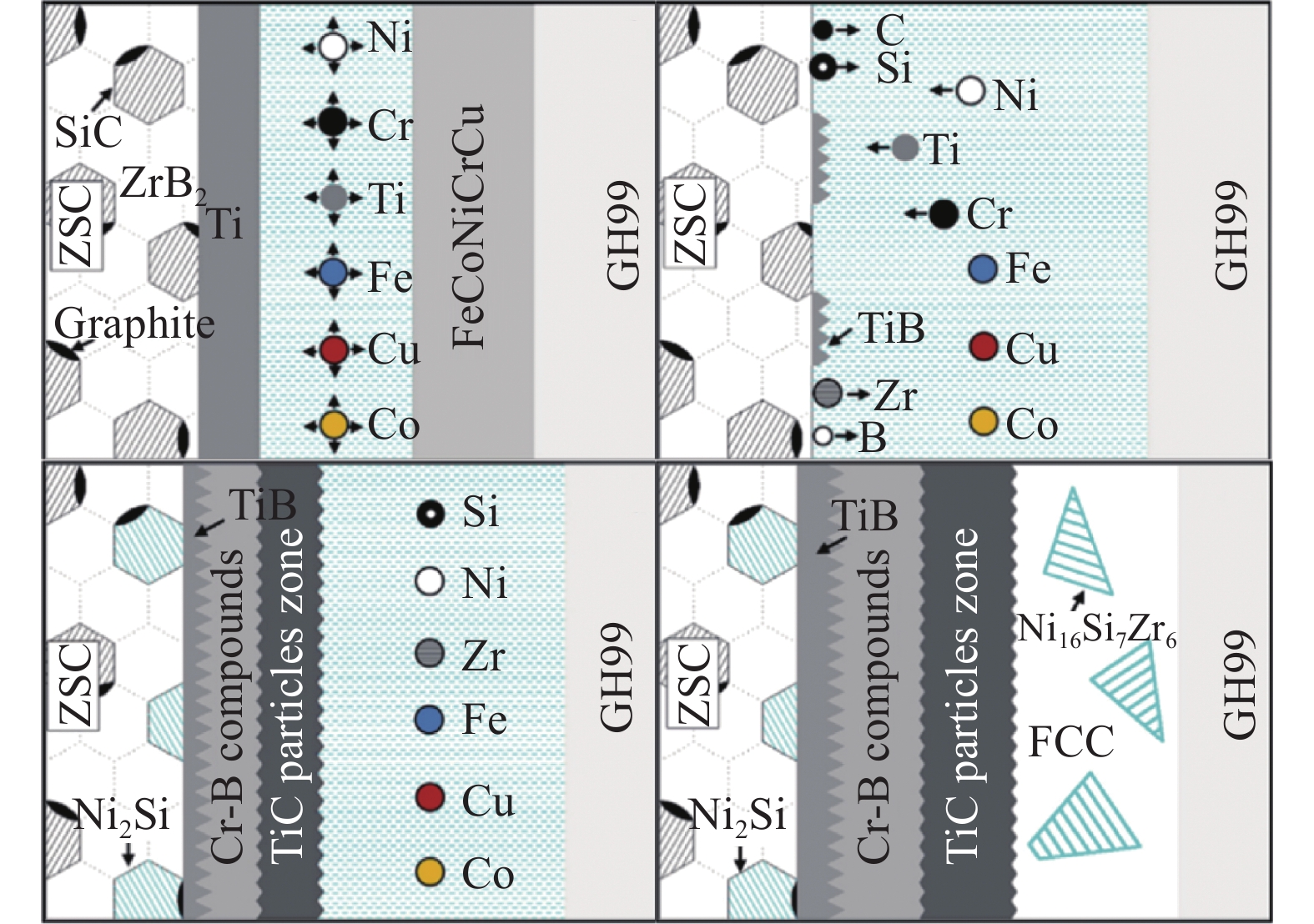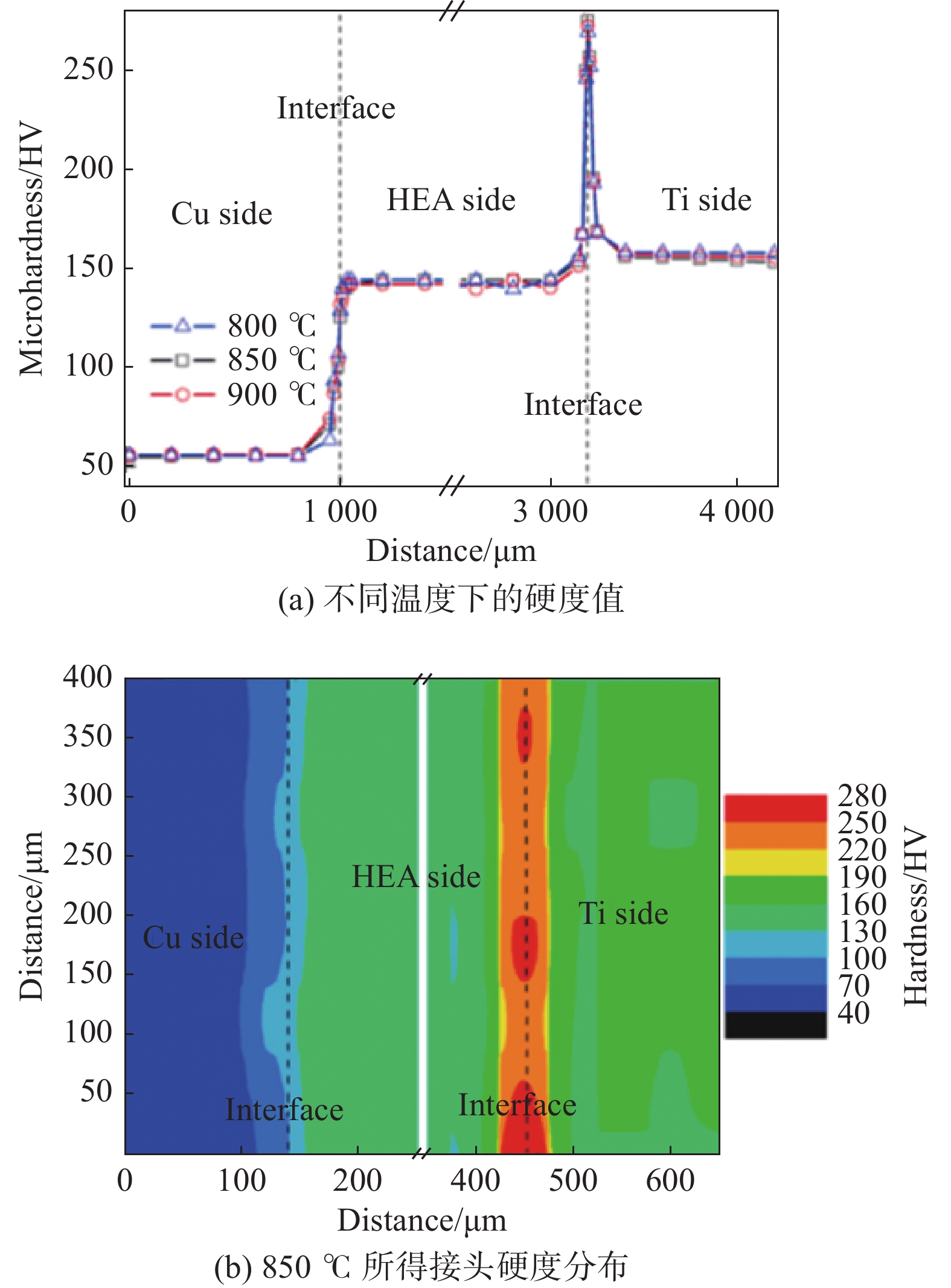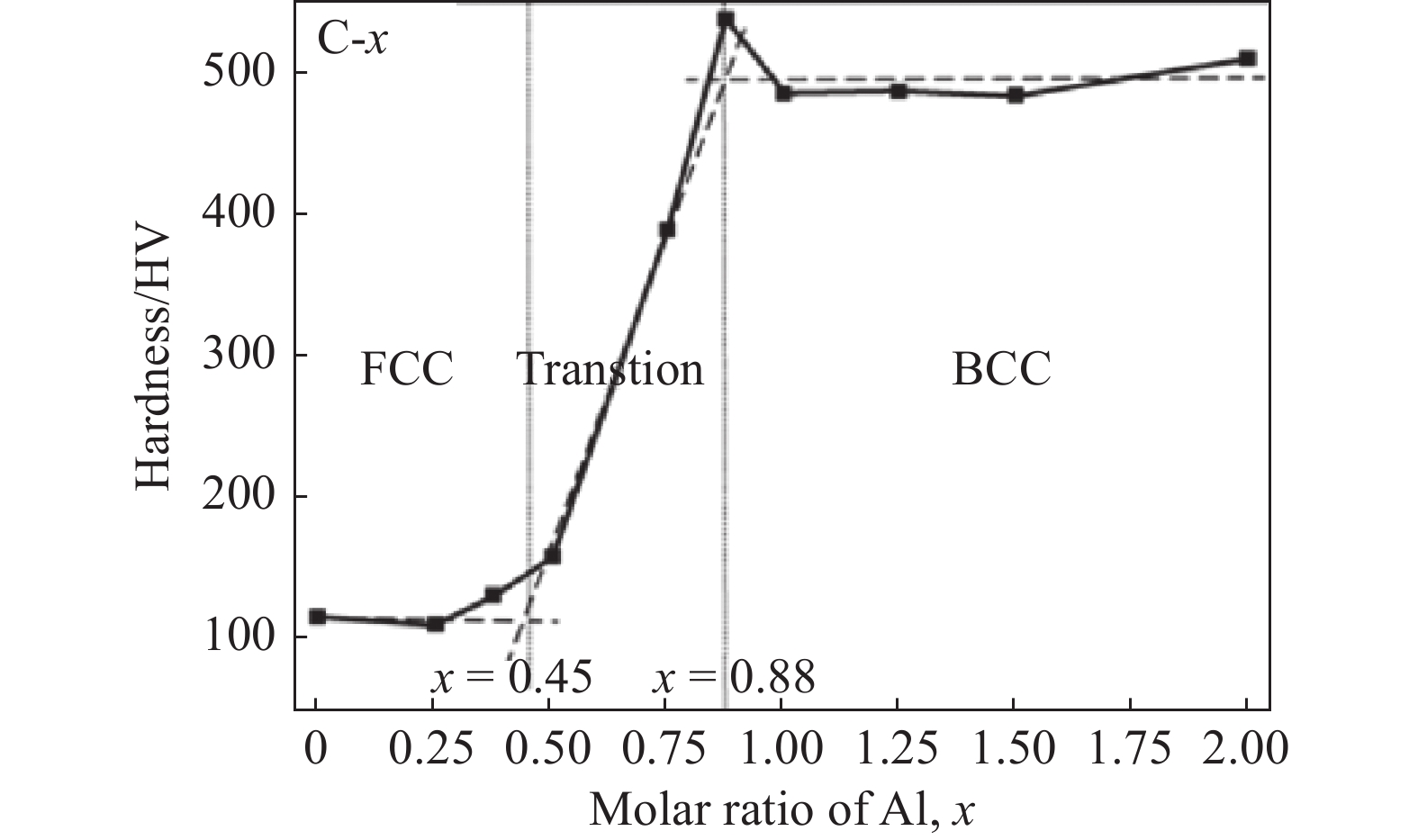Research progress of welding and joining by using the high entropy alloys as filler metals
-
摘要: 高熵合金是近年来快速发展的一种新型合金,其成分设计突破了传统合金的设计理念,是合金理论发展的一个新方向.高熵合金所具有的高熵效应、晶格畸变效应、缓慢扩散效应和鸡尾酒效应在焊接领域表现出独特的应用价值,前景十分广阔.文中总结了国内外利用高熵合金四大效应开发焊接材料与工艺的研究现状和存在的问题,并对未来发展方向进行了展望.Abstract: High entropy alloys (HEAs) are new generation of alloys which have been developed rapidly in recent years. The composition design of HEAs is a breakthrough of the traditional alloy design idea, and it is a new developing direction of alloy theories. With the high entropy effect, severe lattice distortion effect, sluggish diffusion effect and cocktail effect, the HEAs have promising applications in welding fields. This paper summarized the research status and existing problems in developing the welding filler materials and welding processes utilizing the four effects of HEAs, and the trend of development is prospected as well.
-
0. 序言
2004年,台湾国立清华大学Yeh教授[1]提出了高熵合金的概念.高熵合金是由多种不分主次的金属元素组成的复杂合金体系,又称为多主元高混乱度合金.它一般由5种主要元素组成,每种主要元素的原子分数要大于5%,且不能超过35%.
目前普遍认为高熵合金具有四大效应:热力学上的高熵效应、结构上的晶格畸变效应、动力学上的缓慢扩散效应和性能上的“鸡尾酒”效应.由于上述四大效应的存在,高熵合金呈现出一些新的特点,比如其微观结构为简单固溶体、性能上具有高强度和高硬度等[2–5].
随着材料工业的发展,异质材料复合构件能够最大限度利用材料各自的优点,起到物尽其用的效果,在工业领域受到广泛的重视.但是由于不同的材料具有不同的物理、化学性质,给异质材料焊接和连接带来了很大的挑战.比如当两种材料化学不相容时,会产生大量的金属间化合物,这些硬而脆的金属间化合物会降低焊接接头的力学性能,严重影响焊接结构的服役性能[6–8].
鉴于高熵合金在结构和性能上的显著特点,考虑到异质材料焊接所面临的难题,将高熵合金作为焊接填料引入到焊接接头中,实现焊缝高熵化,可为异质材料焊接和连接提供新的解决途径.目前研究学者针对这一新的方向已开展了部分研究,取得了一些研究成果.文中总结了国内外利用高熵合金四大效应开发焊接材料和工艺的研究现状及存在的问题,并对未来发展方向进行了展望.
1. 焊缝高熵化的研究现状
1.1 热力学上的高熵效应
多主元的特性造成高熵合金的混合熵很高,各组成元素自由无序地分布,形成了简单的无基元固溶体,而不是结构复杂的物相或化合物,称为高熵效应.高熵效应是高熵合金最重要的特征,能够抑制金属间化合物的出现,促进组元间形成简单的体心立方或面心立方固溶体,而不是形成金属间化合物[9–12].
异质材料焊接过程中,当两种材料化学不相容时,界面处易产生大量脆性金属间化合物,严重降低接头的力学性能,限制了异质材料零件在诸多领域中的应用.因此如何消除异质材料焊接接头中的脆性金属间化合物,是异质材料焊接所要解决的关键问题[13–15].
对于易产生大量金属间化合物的异种材料焊接,如果以高熵合金作为焊接填料,或者在界面处原位生成高熵合金,使得异质材料连接界面处形成单一或者多种固溶体结构,就可以避免金属间化合物的产生.
目前国内外学者在利用高熵合金的高熵效应进行异质材料焊接方面进行了初步的尝试,所采用的焊接方法主要集中在压力焊、钎焊、熔化焊等方面.
1.1.1 压力焊
在国内,西安理工大学翟秋亚教授课题组[16-17]提出了基于焊缝金属高熵化的钛/钢电阻点焊中间层设计思路.以等摩尔合金Ti-Fe-Cu-Ni-Al为基点,通过调整高熵合金成分,可有效抑制焊缝脆性金属间化合物产生,形成简单固溶体的TA2/Q235电阻点焊接头组织.同样TA1/Fe5Co24Ni27Cu25Cr19/0Cr18Ni9的储能焊熔核也实现了高熵化,避免了金属间化合物的产生[18].Azhari-Saray等人[19]以Al0.5FeCoCrNi高熵合金作为过渡层进行6061-T6铝合金与St-12碳钢的电阻焊,发现在碳钢侧形成了固溶体,而在铝合金侧形成了复杂的化合物相,主要是由于高熵合金的组成元素向铝合金大量扩散所致.
在固相扩散焊领域,对于容易形成金属间化合物的异种金属焊接,在两者之间加一个高熵合金的中间层,其对两种金属的主要元素有一定的容纳能力,可以在一定程度上减少甚至阻止金属间化合物的产生.刘玉林等人[20]采用真空扩散焊方法实现了CoCrFeMnNi高熵合金与304不锈钢的稳固连接,高熵合金与不锈钢在界面处形成了FCC固溶体层,未发现金属间化合物.
1.1.2 钎焊
目前焊缝高熵化的研究主要集中在采用高熵合金钎料进行金属、陶瓷和金属间化合物等同种和异种材料的钎焊[21].
Zhang等人[22]采用Ti/FeCoNiCrCu高熵合金的复合中间层实现了ZrB2-SiC-C陶瓷与GH99高温合金的钎焊连接,并给出了接头形成的物理模型,如图1所示.Ti/FeCoNiCrCu的混合高熵效应保持了Ti与Cr原子的活性,在钎缝中形成了单相固溶体的基体.
Wang等人[23]采用CoFeCrNiCu高熵合金实现了SiC陶瓷的钎焊,其界面除了形成固溶体外还形成了Cr23C6化合物相.而且由于高熵合金钎料中的元素与两边母材相互扩散,造成其成分变化.添加Ti元素可以补偿CoFeNiCrCu高熵合金钎料向ZrB2-SiC陶瓷和Nb合金母材溶解造成的成分变化,但是钎缝的单一固溶体组织中产生了富钛的Laves金属间化合物相[24].随着钎焊时间的增加,接头因高熵效应的作用仍主要由固溶体组成,接头中反应层厚度逐渐增大[25].
Tillmann等人[26]采用以Ga作为降熔元素的CoCrCuFeNiGa高熵合金钎料实现了较大钎缝下的Mar-M 247镍基高温合金的钎焊,发现接头处形成了两种FCC的高熵合金相,并且在局部形成了高硬度的富Ni,Ti和Ga相.在γ-TiAl/TiZrNiCuCo/IN718钎焊接头靠近γ-TiAl的反应层也形成了Ti-Ni(Cu)-Al金属间化合物[27].
Pang等人[28]采用多主元合金Ti50Zr27Cu8Ni4Co3Fe2Al3Sn2Si1非晶钎料进行钛合金的钎焊,发现钎料中降低Cu和Ni元素的含量可减少金属间化合物的产生.Dong等人[29]采用低熔点的Ti35Zr25Be30Co10非晶钎料焊接TiAl基合金与GH536高温合金,发现较高的温度易导致焊缝中形成金属间化合物.同样,Gao等人[30]采用Fe5Co20Ni20Mn35Cu20多主元合金钎焊镍基高温合金,当钎焊时间超过90 min后,界面处会形成CrMn2和Cr2Mn3金属间化合物.Tillmann等人[31]采用Nb0.73CoCrFeNi2.1共晶高熵合金钎焊3YSZ陶瓷与Crofer 22 APU钢,发现钎缝由FCC固溶体与C14 Laves相的共晶组织构成,在陶瓷界面处产生了HfO2的反应层.
综上,采用高熵合金进行同种和异种材料钎焊时,钎缝中的反应产物受到钎料成分、钎焊温度和时间等参数的综合影响,在形成固溶体组织的同时还常常会形成化合物相,尚不能完全实现钎缝的高熵化.
1.1.3 熔化焊
在异种材料的熔化焊过程中,由于热输入较大且材料发生熔化,接头处极易产生脆性金属间化合物.如果采用高熵合金作为填料,在焊接过程中,熔池金属如同一个高熵化的缓和区,同时容纳了两种母材金属的溶解,并且依然形成高熵合金,可避免形成金属间化合物.
Liu等人[32]使用CoZnCuMn0.8Si0.2和FeCoCrNiMn两种高熵合金粉末得到了6061铝合金和304不锈钢激光焊接的高熵合金焊缝,但是在铝合金侧的焊缝和热影响区界面处产生一个10 ~ 20 μm宽度的未充分混合区,如图2所示,该区域仍然存在亚微米或纳米尺度的金属间化合物.
Hao等人[33]采用(CoCrFeNi)100-xCux高熵合金丝材作为填料得到了TC4钛合金和304不锈钢由固溶体组成的激光焊接焊缝,但是在Ti/Cu过渡区形成了Ti(Fe, Co, Cr)2和Ti(Fe, Ni)2相,使得焊接接头抗拉强度降低,所有接头均在该处发生断裂. 侯光远[34]选用Ti-Fe-Ni-Cu-V和Ti-Fe-Cr-Ni-Cu系高熵合金实现了TA2/Q235和TA2/0Cr18Ni9的TIG熔化焊,通过正交试验得出了优化的焊材成分,焊缝均形成简单固溶体.樊丁等人[35]采用预置CrMnFeNiZr高熵合金粉末得到了6010铝合金/钢成形较好的微束等离子熔钎焊接头,但是接头界面区生成较平整的FeAl3金属间化合物层. 因此采用高熵合金作为填料的异种材料熔焊接头组织存在不对称性,在一侧母材界面处形成固溶体,但在另一侧母材界面处常常会形成金属间化合物,同样难以完全实现焊缝的高熵化.
1.1.4 增材制造和激光熔覆
目前增材制造和激光熔覆多采用粉末形式连接同种或异种材料,高熵合金粉末作为中间层,使得连接处的微观组织[36-37]和性能[38-39]等方面更为优异.
激光熔覆法属于堆焊技术中的一种,目前研究大多在钢材基板上制备高熵合金涂层,合金涂层的微观组织、力学性能、抗高温性能和耐磨性能等方面均显著提升[40].
Han等人[41]制备了具有良好抗高温性能的TixNbMoTaW高熵合金涂层,随着Ti元素含量的增加,延伸性和屈服强度提升,并且在达到熔点前后保持了稳定的BCC结构,具有优异的热稳定性.王磊磊等人[42]研究TC4 钛合金板材表面激光熔覆FeCoCrNi高熵合金涂层,得到Ti,Ni组合和Ti,Co组合造成部分物相的聚集,熔覆层由稳定的FCC + BCC混合相构成,微观组织更加均匀.
Wang等人[43]将 CoCrFeNiMn作为中间层实现NiTi合金和304的连接,由于高熵合金的高熵效应大幅度降低了脆性金属化合物的产生,接头抗剪强度增加了6倍.黄留飞等人[44]通过激光熔覆 FeCrCoNiSiB 高熵合金粉末手段,在低碳钢上成功实现异种材料的焊接,形成一种新型的含有49%非晶相的覆层,覆层的磨损率比低碳钢的磨损率低 25.9%.
石杰[45]利用激光选区熔化技术实现了Fe68Mo5Ni5Cr2P12.5C5B2.5铁基非晶粉末和 FeCoCrNiMn高熵合金粉末的混合打印,发现高熵合金连接处的断裂强度超1 GPa, 当铁基非晶质量分数为15%时,连接处的断裂强度可达到1 330 MPa.
在利用高熵合金的高熵效应进行异种材料的增材制造方面的文献很少,研究还非常不充分.
1.2 结构上的晶格畸变效应
晶格畸变效应是指在多主元高熵合金这种无基元的固溶体中,各原子周围都分布着其它不同种类的原子,而不同种类的原子具有不同的原子半径,导致晶格发生严重的畸变.晶格畸变效应是高熵合金具有高强度和高硬度的重要原因[12,46–48].
Bridges等人[49]采用NiMn1.75Fe0.25CoCu高熵合金作为钎料实现了镍基高温合金IN718的激光钎焊,认为钎焊后高熵合金的硬度上升主要来源于Cr原子引入后导致的晶格畸变和“鸡尾酒”效应.
常规钎料得到的钎焊接头往往强度较低,主要是由于钎缝由一些强度较低的低熔点相组成.如果采用高熵合金作为钎料,或者实现钎缝的高熵化,由于存在晶格畸变效应,可以提高钎焊接头的强度.
1.3 动力学上的缓慢扩散效应
动力学上的缓慢扩散效应是指多种不同类型的原子扩散会造成晶格势能波动范围加大,从而产生很多可作为“陷阱”的低晶格势能的晶格间隙,这些“陷阱”能有效地阻碍原子运动.所以产生了原子缓慢扩散效应,也称为迟滞扩散效应[2,50–52].
由于存在缓慢扩散效应,高熵合金在高温下具有有限的扩散动力学,可以作为扩散焊接的阻隔层,避免两种材料直接接触产生金属间化合物.
丁文等人[53]采用CoCrFeMnNi高熵合金作为扩散中间层对Cu/HEA/304SS进行真空扩散连接时,界面形成了连续的浓度梯度. 但是对Cu/HEA/Ti进行真空扩散连接时,Cu/HEA界面各元素在界面处形成了连续的浓度梯度,而HEA/Ti界面处元素则扩散形成多个平台,形成多种金属间化合物(Cr2Ti,Mn2Ti和Ni3Ti),使得该区域硬度上升,如图3所示[54].
在固相扩散焊接过程中,由于不同材料的扩散系数不一样,使得在异质材料扩散焊接界面处易形成孔洞缺陷,这一现象称为Kirkendall效应[55].高熵合金中间层可以降低异质材料扩散焊接过程中的原子扩散速率,进而抑制Kirkendall孔洞的形成. 刘玉林[56]采用固相扩散焊接实现了CoCrFeMnNi高熵合金与铜的良好连接,与钢/铜扩散焊相比,高熵合金/铜扩散焊时的Kirkendall孔洞数量显著减少.
由于存在缓慢扩散效应,高熵合金在凝固过程中元素的迁移和扩散很慢,阻碍了晶粒的形核和长大.当作为钎料时,可以防止母材和钎料的过渡溶解,减少界面处有害相的生成[30].另外由于合金元素在凝固过程中的迁移和扩散很慢,阻碍了晶粒的形核和长大,使得界面处的组织倾向于形成纳米结构,可提高其耐高温性能.因此高熵合金可作为高温结构的钎料,以保证接头在高温服役条件下的力学性能.
在电子封装领域的钎焊过程中,熔化的钎料与基体之间发生界面反应,易形成金属间化合物,焊点处常常在很低的载荷下产生破坏.为解决这一问题,在焊点处形成韧性的多主元合金反应层是一个重要的的思路.
Shen等人[57]研究发现,由于存在缓慢扩散效应,高熵合金FeCoNiMn向锡的溶解非常慢,可作为三维集成电路中小体积锡基焊料/铜焊点间的扩散阻隔材料,在电子封装领域具有广阔的应用前景. Peng等人[58-59]采用AuSn + Au5Sn共晶钎料实现了CuNiAg基体的钎焊,在界面处原位形成了面心立方结构的多主元合金.该合金的形成可以释放局部应力集中,优化应变局部分布,进而增强接头的剪切性能.
在微电子领域,由于高温下Cu元素在Si元素或SiO2中的扩散能力很强,铜引线与硅的连接极易形成Cu-Si金属间化合物,因此二者之间常需要扩散阻隔层.高熵合金由于具有高的热稳定性和有限的扩散动力学,在作为扩散阻隔层材料方面具有极大的潜力. Tsai等人[60]采用AlMoNbSiTaTiVZr高熵合金薄膜作为扩散阻隔层进行铜与硅的连接,发现高熵合金薄膜能在700 ℃,30 min 内阻止Cu-Si化合物的形成.因此高熵合金是一种很有潜力的Cu-Si连接扩散阻隔层材料.
综上,缓慢扩散效应减缓了高熵合金组成原子在高温下的扩散速率,一方面可以作为钎焊和扩散焊的阻隔层,防止界面处形成金属间化合物和Kirkendall孔洞;另一方面,界面处倾向于形成纳米结构,可以用作高温结构钎焊的钎料.
1.4 性能上的“鸡尾酒”效应
性能上的“鸡尾酒”效应是基于主要组元本身特性及其交互作用相结合产生的一种复杂效应.高熵合金的性能受到组成相的综合影响,会产生复合效应,而不仅仅是各相性能的简单混合叠加[61–66].
研究表明,AlxFeCoCrNi高熵合金中,由于“鸡尾酒”效应的存在,Al元素含量的增加使合金结构由FCC相逐渐转变至BCC相,合金的强度逐渐提高,同时伴随塑性的下降.这是由于FCC相具有低强度和高塑韧性,而BCC相具有高强度和低塑韧性. AlxFeCoCrNi高熵合金的硬度随Al元素含量的变化如图4所示[67].利用高熵合金的“鸡尾酒”效应,可通过调控高熵合金焊接填料的成分,调控焊缝中FCC相和BCC相的比例,进而调控焊缝的强度和塑韧性,最终使焊缝获得最优的综合力学性能.
Liu等人[68]采用(CrMnFe)x(CoNi)y系列的高熵合金实现了不锈钢和低碳钢异种材料的激光焊接,发现高的BCC形成元素(x/y>7/3)可以获得硬度较高的焊缝,当x/y=5/5时,焊缝具有最优综合力学性能.Liu等人[69]采用FeCoCrNiMn和CrFeNi2.4Al0.6两种高熵合金作为填料实现了304不锈钢和SMA490BW异种钢激光填粉焊接,发现母材的溶解和填充金属成分的稀释对高熵合金焊缝的组成有重要的影响. 60°V形坡口可以减少母材中的Fe元素向焊缝的溶解,且焊缝显微硬度提高了33%,主要是由于开坡口焊缝中BCC/FCC相的比例较高[70].
共晶高熵合金具有塑性FCC相和高强度BCC相交替分布的片层或棒状显微组织,通过调整合金成分控制FCC/BCC型固溶体的比例,进而调控焊缝的强韧性匹配,有望获得最优的综合力学性能,因此在高性能钢等材料的焊接中具有广阔的应用前景.
2. 目前存在的问题
利用焊缝高熵化的思路来解决异质材料焊接所存在的问题,国内外已初步开展了一些工作,取得了一些成果.但是研究工作仅涉及少数异种材料组合、高熵合金体系和焊接方法,研究还非常不充分,存在如下几个主要问题.
(1)由于所采用的高熵合金填料对不同母材的容纳能力不同,焊接接头的组织和性能存在不对称性.对于给定的材料组合和高熵合金成分,常常出现一侧母材界面处形成固溶体组织,但在另一侧母材界面处仍存在金属间化合物,焊缝常常不能实现完全的高熵化.
(2)采用高熵合金填料焊接过程中,母材的溶解使得母材和焊缝的元素相互扩散,造成高熵合金填料的成分稀释或变化,进而影响焊缝的化学成分,使得焊缝不再具有高熵效应.
(3)对于给定的异质材料组合,在高熵合金体系的选择上大多依赖经验,尚未形成通用的选择依据和准则;在选择高熵合金体系后进一步确定合金成分时也主要依赖经验,大多选择等摩尔比的成分.对于作为焊接填料的成分选择和设计准则,尚无清晰的认识和理论的指导.
3. 未来研究展望
高熵合金所具有的高熵效应、晶格畸变效应、缓慢扩散效应和“鸡尾酒”效应在焊接领域表现出独特的应用价值,前景十分广阔.焊缝高熵化是解决异种材料焊接难题的一个重要思路,文中结合已有研究成果,对该方向未来发展给出以下几点建议.
(1)考虑到母材的溶解对高熵合金焊缝成分的影响,需保证母材溶入后焊缝仍然形成高熵合金. 因此有必要研究母材的合金元素及其含量对高熵合金相组成的影响,确定能够形成固溶体结构的合金元素含量范围,建立不同合金元素含量与相组成之间的关系,揭示其形成规律,为高熵合金焊料成分设计提供理论依据.
(2)系统开展不同材料组合、不同高熵合金体系和不同焊接方法的研究,综合考虑焊缝高熵化、母材溶解、接头服役性能以及经济成本等因素,确定作为焊接填料的高熵合金成分设计准则.
(3)除了采用目前常用的试验手段外,应综合运用热力学参量计算、密度泛函理论、热力学第一性原理仿真、分子动力学第一性原理仿真、新相分计算法、计算相图理论、高通量试验与表征以及有限元模拟等手段进行成分设计,提高效率,降低对经验的依赖.
(4)在高熵合金填料成分设计过程中,综合考虑焊接方法的不同和焊接工艺参数的波动,以及接头服役性能的不同对焊缝高熵化的影响,根据不同的焊接方法和服役环境来选择不同的合金体系.
(5)目前所采用的高熵合金焊接填料主要是单相固溶体材料,利用其高熵效应来减少或避免接头金属间化合物的产生.多相高熵合金,特别是共晶高熵合金能够有效调控强度与韧性的匹配,与单相高熵合金相比具有更优异的综合力学性能.应加强多相高熵合金焊接填料的研究和开发,对相的类型和各相比例生成规律进一步探索,扩大其应用范围.
(6)增材制造在异质材料构件制造中具有显著的优势,将高熵合金作为异质材料构件的过渡层,以避免产生金属间化合物和缓释残余应力,也是未来重要的研究方向.目前相关报道较少,应尽快开展基于高熵合金过渡层的异质材料构件增材制造技术的研究.
-
-
[1] Yeh J W, Chen S K, Lin S J, et al. Nanostructured high-entropy alloys with multiple principal elements: novel alloy design concepts and outcomes[J]. Advanced Engineering Materials, 2004, 6(5): 299 − 303. doi: 10.1002/adem.200300567
[2] Beke D L, Erdelyi G. On the diffusion in high-entropy alloys[J]. Materials Letters, 2016, 164: 111 − 113. doi: 10.1016/j.matlet.2015.09.028
[3] Chen J, Zhou X, Wang W, et al. A review on fundamental of high entropy alloys with promising high-temperature properties[J]. Journal of Alloys and Compounds, 2018, 760: 15 − 30. doi: 10.1016/j.jallcom.2018.05.067
[4] Paul T R, Belovai V, Murch G E. Analysis of diffusion in high entropy alloys[J]. Materials Chemistry and Physics, 2018, 210: 301 − 308. doi: 10.1016/j.matchemphys.2017.06.039
[5] Miracle D B, Senkov O N. A critical review of high entropy alloys and related concepts[J]. Acta Materialia, 2017, 122: 448 − 511. doi: 10.1016/j.actamat.2016.08.081
[6] 张义福, 张华, 苏展展, 等. 钛/钢激光焊接头中脆性化合物调控研究进展[J]. 兵器材料科学与工程, 2019, 29(6): 122 − 129. Zhang Yifu, Zhang Hua, Su Zhanzhan, et al. Research progress on the regulation of brittle compounds in titanium alloy/steel dissimilar metal joint by laser welding[J]. Ordnance Material Science and Engineering, 2019, 29(6): 122 − 129.
[7] 祝要民, 李青哲, 邱然锋, 等. 钛/钢异种金属焊接的研究现状[J]. 电焊机, 2016, 46(11): 78 − 82. Zhu Yaomin, Li Qingzhe, Qiu Ranfeng, et al. Researching status of dissimilar metal welding of titanium and steel[J]. Electric Welding Machine, 2016, 46(11): 78 − 82.
[8] 吕攀, 王克鸿, 朱和国. 钛合金与不锈钢异种金属焊接的研究现状[J]. 热加工工艺, 2017, 46(13): 26 − 32. Lü Pan, Wang Kehong, Zhu Heguo. Research status of titanium alloy and stainless steel dissimilar metal welding[J]. Hot Working Technology, 2017, 46(13): 26 − 32.
[9] Kunce I, Polanski M, Karczewski K, et al. Microstructural characterisation of high-entropy alloy AlCoCrFeNi fabricated by laser engineered net shaping[J]. Journal of Alloys and Compounds, 2015, 648: 751 − 758. doi: 10.1016/j.jallcom.2015.05.144
[10] Choi M, Ondicho I, Park N, et al. Strength–ductility balance in an ultrafine-grained non-equiatomic Fe50(CoCrMnNi)50 medium-entropy alloy with a fully recrystallized microstructure[J]. Journal of Alloys and Compounds, 2019, 780: 959 − 966. doi: 10.1016/j.jallcom.2018.11.265
[11] Xu Y, Bu Y, Liu J, et al. In-situ high throughput synthesis of high-entropy alloys[J]. Scripta Materialia, 2019, 160: 44 − 47. doi: 10.1016/j.scriptamat.2018.09.040
[12] Tong Y, Chen D, Han B, et al. Outstanding tensile properties of a precipitation-strengthened FeCoNiCrTi0.2 high-entropy alloy at room and cryogenic temperatures[J]. Acta Materialia, 2019, 165: 228 − 240. doi: 10.1016/j.actamat.2018.11.049
[13] Srikanth V, Laik A, Dey G K. Joining of stainless steel 304L with Zircaloy-4 by diffusion bonding technique using Ni and Ti interlayers[J]. Materials and Design, 2017, 126(4): 141 − 154.
[14] Jafarian M, Khodabandeh A, Manafi S. Evaluation of diffusion welding of 6061 aluminum and AZ31 magnesium alloys without using an interlayer[J]. Materials and Design, 2015, 65: 160 − 164. doi: 10.1016/j.matdes.2014.09.020
[15] Kundu S, Mishra B, Olson D L, et al. Interfacial reactions and strength properties of diffusion bonded joints of Ti64 alloy and 17-4PH stainless steel using nickel alloy interlayer[J]. Materials and Design, 2013, 51: 714 − 722. doi: 10.1016/j.matdes.2013.04.088
[16] 陈凯, 翟秋亚, 田健, 等. 基于高熵合金中间层的TA2与Q235电阻焊研究[J]. 现代焊接, 2013, 8(41): 36 − 38. Chen Kai, Zhai Qiuya, Tian Jian, et al. The resistance welding of TA2 and Q235 base on high entorpy Interlayer alloys[J]. Modern Welding Technology, 2013, 8(41): 36 − 38.
[17] 徐锦锋, 郭嘉宝, 田健, 等. 基于焊缝金属高熵化的钛/钢焊材设计与制备[J]. 铸造技术, 2014, 35(11): 2674 − 2676. Xu Jinfeng, Guo Jiabao, Tian Jian, et al. Design and preparation of welding materials applied to welding titanium and steel based on weldmetal high entropy converting[J]. Foundry Technology, 2014, 35(11): 2674 − 2676.
[18] 杨全虎, 翟秋亚, 徐锦锋, 等. Ta1与0Cr18Ni9薄板的储能焊试验[J]. 焊接学报, 2019, 40(9): 116 − 121. Yang Quanhu, Zhai Qiuya, Xu Jinfeng, et al. Energy storage welding test of Ta1 and 0Cr18Ni9 thin plates[J]. Transactions of the China Welding Institution, 2019, 40(9): 116 − 121.
[19] Azhari-Saray H, Sarkari-Khorrami M, Nademi-Babahadi A, et al. Dissimilar resistance spot welding of 6061-T6 aluminum alloy/St-12 carbon steel using a high entropy alloy interlayer[J]. Intermetallics, 2020, 124(3): 106876.
[20] 刘玉林, 罗永春, 石彦彦. 高熵合金CoCrFeMnNi/不锈钢真空扩散焊[J]. 电焊机, 2016, 46(12): 122 − 127. Liu Yulin, Luo Yongchun, Shi Yanyan. Vacuum diffusion welding between CoCrFeMnNi high entropy and stainless steel[J]. Electric Welding Machine, 2016, 46(12): 122 − 127.
[21] 李红, 韩祎, 曹健, 等. 高熵合金在钎焊和表面工程领域的应用研究进展[J]. 材料工程, 2021, 49(8): 1 − 10. doi: 10.11868/j.issn.1001-4381.2020.000950 Li Hong, Han Yi, Cao Jian, et al. Research progress in high-entropy alloys used in brazing and surface engineering fields[J]. Journal of Materials Engineering, 2021, 49(8): 1 − 10. doi: 10.11868/j.issn.1001-4381.2020.000950
[22] Zhang L X, Shi J M, Li H W, et al. Interfacial microstructure and mechanical properties of ZrB2-SiC-C ceramic and GH99 superalloy joints brazed with a Ti-modified FeCoNiCrCu high-entropy alloy[J]. Materials & Design, 2016, 97: 230 − 238. doi: 10.1016/j.matdes.2016.02.055
[23] Wang G, Yang Y, He R, et al. A novel high entropy CoFeCrNiCu alloy filler to braze SiC ceramics[J]. Journal of the European Ceramic Society, 2020, 40(9): 3391 − 3398. doi: 10.1016/j.jeurceramsoc.2020.03.044
[24] Yang Y, Wang G, He R, et al. Microstructure and mechanical properties of ZrB2-SiC/Nb joints brazed with CoFeNiCrCuTix high-entropy alloy filler[J]. Journal of the American Ceramic Society, 2021, 104(7): 2992 − 3003. doi: 10.1111/jace.17732
[25] 王秒, 王微, 杨云龙, 等. 钎焊时间对 CoFeNiCrCu 高熵钎料钎焊SiC陶瓷接头组织与性能影响[J]. 航空学报, 2021, 42: 1 − 9. Wang Miao, Wang Wei, Yang Yunlong, et al. Effect of brazing time on microstructure and properties of SiC ceramic joint brazed with cofenicrcu high entropy solder[J]. Journal of Aeronautics, 2021, 42: 1 − 9.
[26] Tillmann W, Ulitzka T, Wojarski L, et al. Development of high entropy alloys for brazing applications[J]. Welding in the World, 2020, 64(1): 201 − 208. doi: 10.1007/s40194-019-00824-y
[27] Kokabi D, Kaflou A. TiAl/IN718 dissimilar brazing with TiZrNiCuCo high-entropy filler metal: phase characterization and fractography[J]. Welding in the World, 2021, 65(6): 1189 − 1198. doi: 10.1007/s40194-021-01075-6
[28] Pang S, Sun L, Xiong H, et al. A multicomponent TiZr-based amorphous brazing filler metal for high-strength joining of titanium alloy[J]. Scripta Materialia, 2016, 117: 55 − 59. doi: 10.1016/j.scriptamat.2016.02.006
[29] Dong K W, Kong J, Yang Y, et al. Vacuum brazing of TiAl-based alloy and GH536 superalloy with a low-melting point amorphous Ti35Zr25Be30Co10 filler[J]. Journal of Manufacturing Processes, 2019, 47(5): 410 − 418.
[30] Gao M, Schneiderman B, Gilbert S M, et al. Microstructural evolution and mechanical properties of nickel-base superalloy brazed joints using a MPCA filler[J]. Metallurgical and Materials Transactions A, 2019, 50(11): 5117 − 5127. doi: 10.1007/s11661-019-05386-8
[31] Tillmann W, Wojarski L, Stangier D, et al. Application of the eutectic high entropy alloy Nb0.73CoCrFeNi2.1 for high temperature joints[J]. Welding in the World, 2020, 64(9): 1597 − 1604. doi: 10.1007/s40194-020-00944-w
[32] Liu D, Wang J, Xu M, et al. Evaluation of dissimilar metal joining of aluminum alloy to stainless steel using the filler metals with a high-entropy design[J]. Journal of Manufacturing Processes, 2020, 58(7): 500 − 509.
[33] Hao X, Dong H, Xia Y, et al. Microstructure and mechanical properties of laser welded TC4 titanium alloy/304 stainless steel joint with (CoCrFeNi)100- xCu x high-entropy alloy interlayer[J]. Journal of Alloys and Compounds, 2019, 803: 649 − 657. doi: 10.1016/j.jallcom.2019.06.225
[34] 侯光远. 基于焊缝金属高熵化的钛/钢TIG焊研究[D]. 西安: 西安理工大学, 2015. Hou Guangyuan. Reserch on gtaw of titanium and steel based on the weld metal high-entroy[D]. Xi′an: Xi′an University of Technology, 2015.
[35] 樊丁, 康玉桃, 黄健康, 等. 铝/钢预置高熵合金粉末对接接头组织及力学性能[J]. 兰州理工大学学报, 2019, 45(6): 1 − 5. doi: 10.3969/j.issn.1673-5196.2019.06.001 Fan Ding, Kang Yutao, Huang Jiankang, et al. Microstructure and mechanical performance of butt joint of aluminum and steel welded with preset high-entropy alloy powder[J]. Journal of Lanzhou University of Technology, 2019, 45(6): 1 − 5. doi: 10.3969/j.issn.1673-5196.2019.06.001
[36] 鲁一荻, 张骁勇, 彭志刚. 合金元素对激光熔覆高熵合金涂层影响的研究进展[J]. 焊接, 2021(10): 8 − 14. Lu Yidi, Zhang Xiaoyong, Peng Zhigang. Research progress on the effect of alloying elements on laser cladding high entropy alloy coating[J]. Welding & Joining, 2021(10): 8 − 14.
[37] Guo Wei, Cai Yan. Effect of laser remelting on microstructure and mechanical properties of CrMnFeCoNi high entropy alloy[J]. China Welding, 2021, 30(2): 1 − 10.
[38] Kenel C, Casati N P M, Dunand D C, et al. 3D ink-extrusion additive manufacturing of CoCrFeNi high-entropy alloy micro-lattices.[J]. Nature Communications, 2019, 10(1): 1 − 8. doi: 10.1038/s41467-019-08763-4
[39] 杨东青, 王小伟, 黄勇, 等. 熔化极电弧增材制造 18Ni 马氏体钢组织和性能[J]. 焊接学报, 2020, 41(8): 6 − 9. doi: 10.12073/j.hjxb.20200608002 Yang Dongqing, Wang Xiaowei, Huang Yong, et al. Microstructure and mechanical properties of 18Ni maraging steel deposited by gas metal arc additive manufacturing[J]. Transactions of the China Welding Institution, 2020, 41(8): 6 − 9. doi: 10.12073/j.hjxb.20200608002
[40] 高绪杰, 郭娜娜, 朱光明, 等. 激光熔覆制备高熵合金涂层的研究进展[J]. 表面技术, 2019, 48(6): 107 − 117. Gao Xujie, Guo Nana, Zhu Guangming, et al. Research progress of high entropy alloy coating prepared by laser cladding[J]. Surface Technology, 2019, 48(6): 107 − 117.
[41] Han Z D, Luan H W, Liu X, et al. Microstructures and mechanical properties of TixNbMoTaW refractory high-entropy alloys-science direct[J]. Materials Science and Engineering:A, 2018, 712: 380 − 385. doi: 10.1016/j.msea.2017.12.004
[42] 王磊磊, 刘婷, 段舒尧, 等. 元素分布对FeCoCrNi高熵合金涂层微观组织的影响[J]. 焊接学报, 2021, 42(11): 57 − 64. Wang Leilei, Liu Ting, Duan Shuyao, et al. Effect of element distribution on microstructure of fecocrni high entropy alloy coating[J]. Transactions of the China Welding Institution, 2021, 42(11): 57 − 64.
[43] Wang H W, Xie J L, Chen Y H, et al. Effect of CoCrFeNiMn high entropy alloy interlayer on microstructure and mechanical properties of laser-welded NiTi/304SS joint[J]. Journal of Materials Research and Technology, 2022, 18: 1028 − 1037. doi: 10.1016/j.jmrt.2022.03.022
[44] 黄留飞, 孙耀宁, 季亚奇, 等. 激光熔化沉积 AlCoCrFeNi2.5 高熵合金的组织与力学性能研究[J]. 中国激光, 2021, 48(6): 103 − 110. Huang Liufei, Sun Yaoning, Ji Yaqi, et al. Investigation of microstructure and mechanical properties of laser-melting-deposited AlCoCrFeNi2.5 high entroy alloy[J]. Chinese Journal of Lasers, 2021, 48(6): 103 − 110.
[45] 石杰. 3D 打印高熵合金—铁基非晶合金复合材[D]. 武汉: 华中科技大学, 2019. Shi Jie. Processing high entropy alloy-Fe-based amorphous alloy composites by 3D-printing[D]. Wuhan: Huazhong University of Science and Technology, 2019.
[46] Wu Z, David S A, Leonard D N, et al. Microstructures and mechanical properties of a welded CoCrFeMnNi high-entropy alloy[J]. Science and Technology of Welding and Joining, 2018, 23(7): 585 − 595. doi: 10.1080/13621718.2018.1430114
[47] Wu S W, Wang G, Jia Y D, et al. Enhancement of strength-ductility trade-off in a high-entropy alloy through a heterogeneous structure[J]. Acta Materialia, 2019, 165: 444 − 458. doi: 10.1016/j.actamat.2018.12.012
[48] Kim J H, Lim K R, Won J W, et al. Mechanical properties and deformation twinning behavior of as-cast CoCrFeMnNi high-entropy alloy at low and high temperatures[J]. Materials Science and Engineering A, 2018, 712: 108 − 113. doi: 10.1016/j.msea.2017.11.081
[49] Bridges D, Zhang S, Lang S, et al. Laser brazing of a nickel-based superalloy using a Ni-Mn-Fe-Co-Cu high entropy alloy filler metal[J]. Materials Letters, 2018, 215: 11 − 14.
[50] Dabrowa J, Zajusz M, Kucza W, et al. Demystifying the sluggish diffusion effect in high entropy alloys[J]. Journal of Alloys and Compounds, 2019, 783: 193 − 207. doi: 10.1016/j.jallcom.2018.12.300
[51] Kottke J, Laurent-Brocq M, Fareed A, et al. Tracer diffusion in the Ni–CoCrFeMn system: Transition from a dilute solid solution to a high entropy alloy[J]. Scripta Materialia, 2019, 159: 94 − 98. doi: 10.1016/j.scriptamat.2018.09.011
[52] Tsai K Y, Tsai M H, Yeh J W. Sluggish diffusion in Co-Cr-Fe-Mn-Ni high-entropy alloys[J]. Acta Materialia, 2013, 61(13): 4887 − 4897. doi: 10.1016/j.actamat.2013.04.058
[53] 丁文, 王小京, 刘宁, 等. CoCrFeMnNi高熵合金作为中间层的Cu/304不锈钢扩散连接研究[J]. 金属学报, 2020, 56(8): 1084 − 1090. Ding Wen, Wang Xiaojing, Liu Ning, et al. Diffusion bonding of copper and 304 stainless steel with an interlayer of CoCrFeMnNi high-entropy alloy[J]. Acta Metallurgica Sinica, 2020, 56(8): 1084 − 1090.
[54] Ding W, Liu N, Fan J, et al. Diffusion bonding of copper to titanium using CoCrFeMnNi high-entropy alloy interlayer[J]. Intermetallics, 2021, 129: 107027. doi: 10.1016/j.intermet.2020.107027
[55] Sabetghadam H, HanzakiI A Z, Araee A. Diffusion bonding of 410 stainless steel to copper using a nickel interlayer[J]. Materials Characterization, 2010, 61(6): 626 − 634. doi: 10.1016/j.matchar.2010.03.006
[56] 刘玉林. 高熵合金与铝、铜及不锈钢异种材料扩散焊研究[D]. 兰州: 兰州理工大学, 2016. Liu Yulin. The study of diffusion welding of high entropy alloy with aluminum, copper and stainless steel[D]. Lanzhou : Lanzhou University of Technology , 2016.
[57] Shen Y A, Chen S W, Chen H Z, et al. Extremely thin interlayer of multi-element intermetallic compound between Sn-based solders and FeCoNiMn high-entropy alloy[J]. Applied Surface Science, 2021, 558(100): 149945.
[58] Peng J, Wang M, Sadeghi B, et al. Increasing shear strength of Au-Sn bonded joint through nano-grained interfacial reaction products[J]. Journal of Materials Science, Springer US, 2021, 56(11): 7050 − 7062. doi: 10.1007/s10853-020-05623-1
[59] Peng J, Liu H, Fu L, et al. Multi-principal-element products enhancing Au-Sn-bonded joints[J]. Journal of Alloys and Compounds, 2021, 852: 157015. doi: 10.1016/j.jallcom.2020.157015
[60] Tsai M H, Yeh J W, Gan J Y. Diffusion barrier properties of AlMoNbSiTaTiVZr high-entropy alloy layer between copper and silicon[J]. Thin Solid Films, 2008, 516(16): 5527 − 5530. doi: 10.1016/j.tsf.2007.07.109
[61] Qiu X W, Zhang Y P, Liu C G. Effect of Ti content on structure and properties of Al2CrFeNiCoCuTix high-entropy alloy coatings[J]. Journal of Alloys and Compounds, 2014, 585: 282 − 286. doi: 10.1016/j.jallcom.2013.09.083
[62] Qiu X. Microstructure, hardness and corrosion resistance of Al2CoCrCuFeNiTix high-entropy alloy coatings prepared by rapid solidification[J]. Journal of Alloys and Compounds, 2018, 735: 359 − 364. doi: 10.1016/j.jallcom.2017.11.158
[63] Shang C, Axinte E, Sun J, et al. CoCrFeNi(W1− xMo x) high-entropy alloy coatings with excellent mechanical properties and corrosion resistance prepared by mechanical alloying and hot pressing sintering[J]. Materials & Design, 2017, 117: 193 − 202. doi: 10.1016/j.matdes.2016.12.076
[64] Shu F, Yang B, Dong S, et al. Effects of Fe-to-Co ratio on microstructure and mechanical properties of laser cladded FeCoCrBNiSi high-entropy alloy coatings[J]. Applied Surface Science, 2018, 450: 538 − 544. doi: 10.1016/j.apsusc.2018.03.128
[65] Jiang Y Q, Li J, Juan Y F, et al. Evolution in AlCoCrxFeNi high-entropy alloy coatings fabricated by laser cladding[J]. Journal of Alloys and Compounds, 2019, 775: 1 − 14. doi: 10.1016/j.jallcom.2018.10.091
[66] Seol J B, Bae J W, LI Z, et al. Boron doped ultrastrong and ductile high-entropy alloys[J]. Acta Materialia, 2018, 151: 366 − 376. doi: 10.1016/j.actamat.2018.04.004
[67] Kao Y F, Chen T J, Chen S K, et al. Microstructure and mechanical property of as-cast, -homogenized, and -deformed Al xCoCrFeNi (0 ≤ x ≤ 2) high-entropy alloys[J]. Journal of Alloys and Compounds, 2009, 488(1): 57 − 64.
[68] Liu D, Guo R, Hu Y, et al. Effects of the elemental composition of high-entropy filler metals on the mechanical properties of dissimilar metal joints between stainless steel and low carbon steel[J]. Journal of Materials Research and Technology, 2020, 9(5): 11453 − 11463. doi: 10.1016/j.jmrt.2020.08.028
[69] Liu D, Guo R, Hu Y, et al. Dissimilar metal joining of 304 stainless steel to SMA490BW steel using the filler metal powders with a high-entropy design[J]. Metals and Materials International, 2020, 26(6): 854 − 866. doi: 10.1007/s12540-019-00400-5
[70] Liu D, Wang W, Zha X, et al. Effects of groove on the microstructure and mechanical properties of dissimilar steel welded joints by using high-entropy filler metals[J]. Journal of Materials Research and Technology, 2021, 13(4): 173 − 183.




 下载:
下载:



